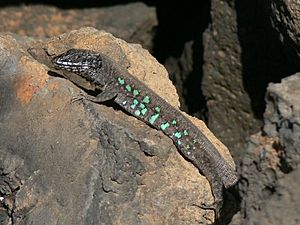Atlantic lizard facts for kids
Quick facts for kids Atlantic lizard |
|
|---|---|
 |
|
| Gallotia atlantica atlantica | |
| Conservation status | |
| Scientific classification | |
| Genus: |
Gallotia
|
| Species: |
atlantica
|
The Atlantic lizard (Gallotia atlantica) is a cool type of lizard that belongs to the Lacertidae family. These lizards are special because they are found only in one place in the world! They live on the eastern Canary Islands, which are a group of islands off the coast of Africa.
You can find them on the main islands of Lanzarote and Fuerteventura. They also live on the smaller islands nearby.
Contents
About the Atlantic Lizard
Where do Atlantic lizards live?
Atlantic lizards are endemic to the Canary Islands. This means they naturally live nowhere else on Earth. Their homes are quite varied! They can be found in places like:
- Temperate forests
- Areas with lots of shrubland
- Mediterranean-style bushy areas
- Rocky places and rocky shores
- Sandy beaches
- Farm fields (called arable land)
- Grassy areas where animals graze (pastureland)
- Even in gardens in the countryside
What do Atlantic lizards look like?
Atlantic lizards are usually small to medium-sized. They have a slender body and a long tail. Their skin can be different shades of brown, gray, or black. Some might even have cool patterns or spots! These colors help them blend in with their surroundings. This is a great way to hide from predators.
What do Atlantic lizards eat?
These lizards are mostly insectivores. This means they love to munch on insects! Their diet often includes:
- Small insects
- Spiders
- Other tiny invertebrates
Sometimes, they might also eat small bits of plants or fruit. This helps them get all the nutrients they need to stay healthy.
How do Atlantic lizards behave?
Atlantic lizards are active during the day. They love to bask in the sun to warm up their bodies. You might see them scurrying across rocks or hiding under bushes. They are very quick and agile. This helps them catch their food and escape from danger.
Like many lizards, they can drop their tail if a predator grabs it. This is a clever trick to get away! The tail will grow back later.
Are Atlantic lizards in danger?
The Atlantic lizard is currently listed as "Least Concern" by the IUCN. This means they are not in immediate danger of disappearing. However, their habitats can be affected by human activities. Things like building new homes or farms can change their environment. It's important to protect their natural homes so these unique lizards can continue to thrive.
See also
 In Spanish: Lagarto atlántico para niños
In Spanish: Lagarto atlántico para niños


